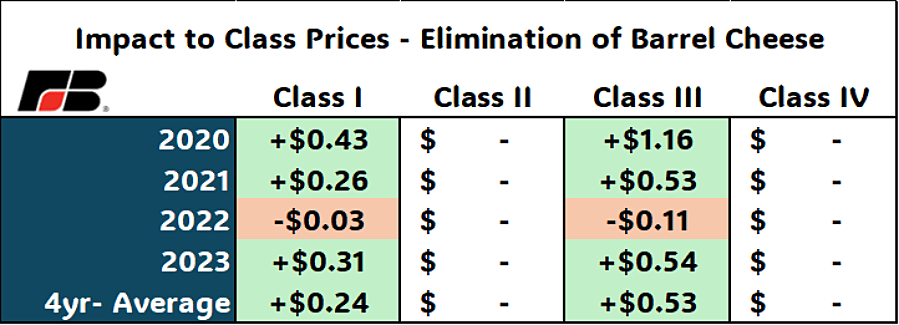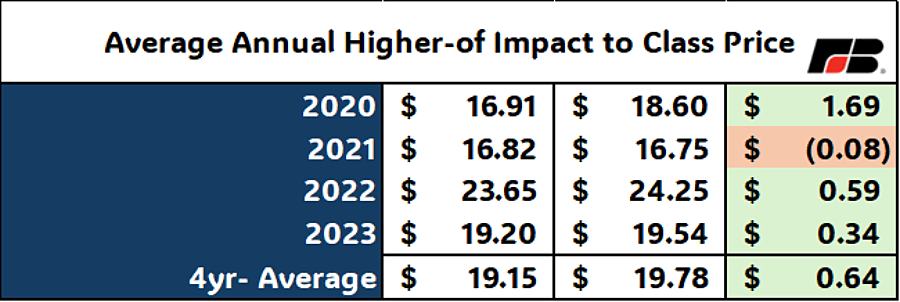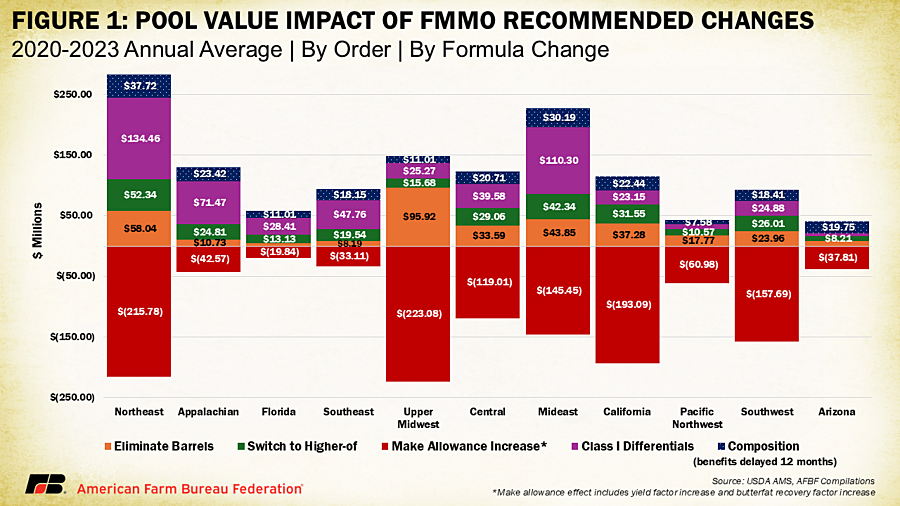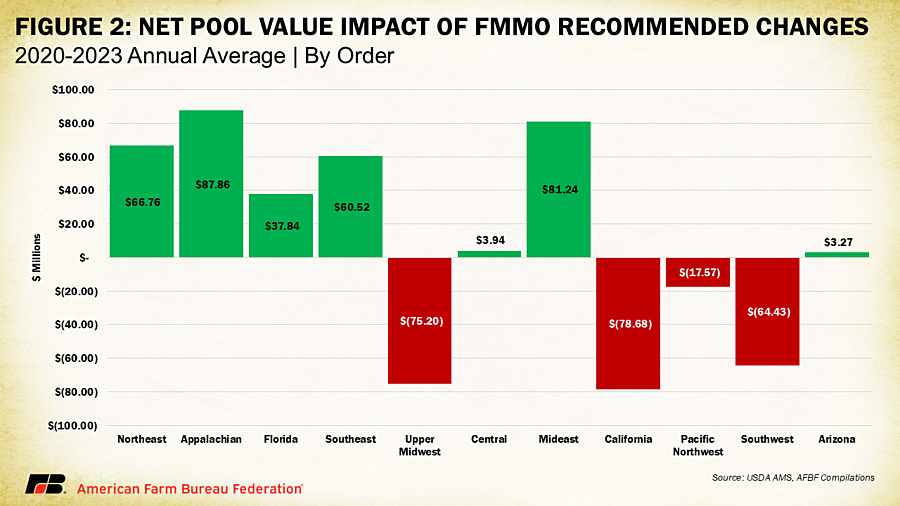Decoding USDA’s FMMO Recommendations
TOPICS
FMMO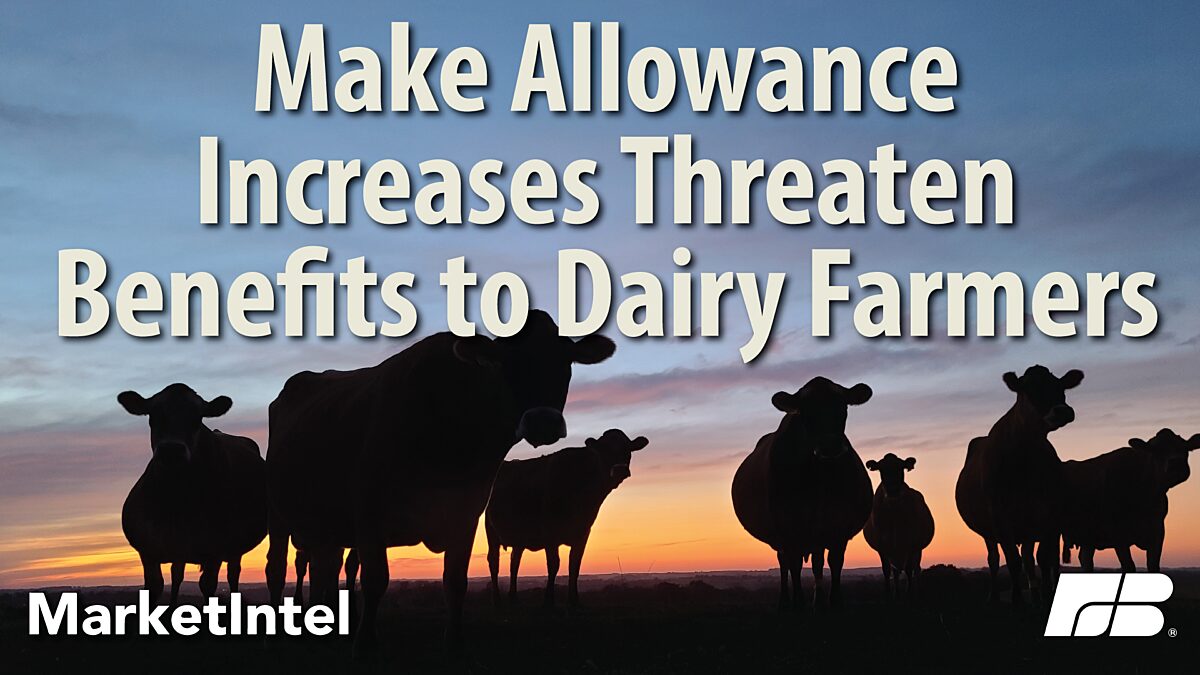
Daniel Munch
Economist
The USDA-Agricultural Marketing Service's proposed amendments to the 11 Federal Milk Marketing Orders (FMMOs), released on July 1, are a mixed outcome for dairy farmers, with the benefits—or lack thereof—largely dependent on the farmer's location. These recommendations reflect USDA's interpretation of testimony from the Carmel, Indiana, hearing (August 2023-January 2024) and post-hearing briefs from stakeholders.
The proposed amendments include changes to milk composition factors, surveyed commodity products, Class III and IV formula factors (make allowances), the base Class I skim milk price, and Class I differentials.
This article provides a broad overview of the potential impact of the recommended changes. For a comprehensive review of each proposal, its history, and AFBF’s stance, please refer to the extended version of this article here.
1. Milk Composition Factors
For FMMOs, USDA formulas assume certain milk composition levels in skim milk. The current assumption is that 100 pounds of skim milk contains 3.1 pounds of protein and 5.9 pounds of other solids. However, due to improved farming practices, protein levels have risen since these assumptions were last updated in 2000.
USDA proposes increasing the assumption of protein to 3.3 pounds and of other solids to 6 pounds for a total of 9.3 pounds of nonfat solids, which corresponds to higher Class prices across the board. On average, from 2020-2023, Class I prices would have increased 46 cents/cwt; Class II prices would have increased by 32 cents/cwt; Class III prices would have increased by 57 cents/cwt; and Class IV prices would have increased by 32 cents/cwt.
This is a positive change for farmers, as it more accurately reflects milk’s current market value. However, USDA recommends delaying these changes by 12 months, potentially costing farmers over $200 million in lost revenue during that time.
2. Surveyed Commodity Products
FMMO prices are based on surveys of wholesale dairy product prices. Currently, cheddar cheese prices are determined using 40-pound blocks and 500-pound barrels, though the barrel price has become increasingly volatile and less reflective of the broader market.
USDA proposes eliminating 500-pound barrels from the survey, which would stabilize prices and better reflect market realities. If implemented over the past four years, this change would have increased the Class I price by 24 cents/cwt and the Class III price by 53 cents/cwt.
3. Class III & IV Formula Factors (Make Allowances)
Make allowances account for manufacturing costs, such as labor, energy and packaging. USDA’s proposal includes significant increases to make allowances, which reduce the prices farmers receive. USDA recommends the cheese make allowance increase by 5 cents, the butter make allowance increase by 5.4 cents, the nonfat dry milk make allowance increase by 5.9 cents and the dry whey make allowance increase by 6.6 cents. Had these higher values been in place between 2020-2023 they would have reduced Class prices by between 74 cents and 89 cents per hundredweight.
These reductions would negatively affect dairy farmers, particularly in regions with high Class III and IV utilization, and are strongly opposed by the American Farm Bureau Federation who argued that more comprehensive data was necessary to take this much money away from farmers, particularly when the current make allowances have been big enough for manufacturers to build or expand cheese plants in various regions of the country. This topic was explored more in-depth here.
4. Base Class I Skim Milk Price
The Class I skim milk price is currently based on the average of Class III and IV skim prices. However, market volatility revealed flaws in this system, as large discrepancies between Class prices led to substantial losses for dairy farmers. USDA recommends reverting to the previous "higher-of" formula, which would have increased Class I prices by 64 cents/cwt over the past four years. This change aligns with dairy farmer priorities.
But wait! There’s more! Instead of the simple switch back to the easy to understand “higher-of,” USDA recommends the addition of an adjuster for extended shelf life (ESL) milk. The adjuster is calculated as the rolling average of the differences between the higher-of and the average-of the advanced Class III and Class IV skim milk pricing factors over the prior 13 to 36 months. This adjuster, announced 12 months in advance, aims to account for fluid milk cost differences but introduces significant complexity and may not effectively stabilize ESL milk prices. Introducing futures and options contracts for Class I milk could provide better risk management and simplify the pricing system.
5. Class I Differentials
Class I differentials account for the cost of transporting milk to fluid markets and have not been comprehensively updated since 1998. USDA proposes increasing differentials across most regions, with the largest increases in the Southeast and Appalachian orders. The average increase would be $1.25/cwt, with some regions seeing as much as a $2.60 increase.
Putting it All Together
One of the key elements of the FMMO system is its pooling mechanism, which ensures that farmers receive a uniform price for their milk, regardless of what it is used for. The intention is to ensure handlers in a similar location who produce similar products pay the same minimum classified price for the raw milk and that farmers producing milk in the same area receive the same price (i.e., uniform pricing). Each month, the total Class values of milk within an order are aggregated, and an average uniform price is calculated. The contributions of different Class prices to the pool can vary significantly depending on the supply and demand conditions within an order. Consequently, the effects of adjustments to Class price formulas on individual orders are best understood once differences in Class utilization and production volumes are accounted for.
Figure 1 illustrates the annual impact of each of USDA's recommended amendments on the total pool value for each order (using an average across 2020-2023 pricing data). In this analysis, each adjustment was made separately and then layered to isolate the effect of each recommendation. However, it's important to note that interactions between different formula factors within the Class price equations were not considered, so the combined effects of these adjustments in real-world scenarios might differ.
Most apparent, the proposed increases in make allowances have significant negative impacts to order pool values, ranging from a pool value impact of -$19.84 million in the Florida order to -$223 million in the Upper Midwest order. All other adjustments positively impact pool values. Composition factor updates contributed to a one-year increase of $220 million across all orders, a benefit that would be inaccessible for the first year due to the proposed implementation delay. The proposed ESL adjustment for the base Class I price was not included as the overall impact on pool values was too minor to visualize.
Figure 2 combines the effects of USDA’s FMMO recommendations and shows the net impact on each order. The proposed increases in make allowances would significantly offset the benefits in several orders, reducing the total pool value by $78 million in the California order, $75 million in the Upper Midwest order, $64 million in the Southwest order, and $17 million in the Pacific Northwest order. If these changes had been implemented in 2020 through 2023, dairy farmers in these four orders would have received lower prices than under the current FMMO system. These orders have higher Class III and IV utilization, making them more vulnerable to the negative effects of increased make allowances. In contrast, orders with higher Class I utilization, such as the Appalachian and Mideast orders, would see an increase in pool value from the proposed changes. Arizona and the Central orders would experience a small but positive benefit. The proposed make allowance increases create disparities among dairy farmers based on their physical location — an outcome that the FMMO system is designed to prevent.
What’s Missing?
AFBF supported additional changes that USDA has not recommended, including a higher Class II differential, elimination of advanced pricing, and the inclusion of 640-lb cheddar blocks and unsalted butter in price surveys. These changes would have further improved market alignment and pricing transparency.
Rulemaking Process
The release of the recommended decisions is the ninth step in the 12-step FMMO rulemaking process. Stakeholders and the public can comment on USDA’s proposals until Sept. 13. After reviewing feedback, USDA will issue a final rule around mid-November, followed by a referendum for dairy farmers and cooperatives to vote on the proposed amendments.
Conclusion
USDA's proposed amendments to the 11 Federal Milk Marketing Orders present both potential benefits and significant concerns for dairy farmers. While the return to the “higher-of” Class I base price, elimination of barrel cheese prices, and increases in composition factors and Class I differentials are steps in the right direction, the large make allowance increases could negate these gains, especially in regions with high Class III and IV utilization.
The delay in implementing composition factor updates and the added complexity of the ESL milk adjuster further complicate the potential outcomes, leaving many dairy farmers uncertain about whether the changes will ultimately work in their favor.
Top Issues
VIEW ALL
